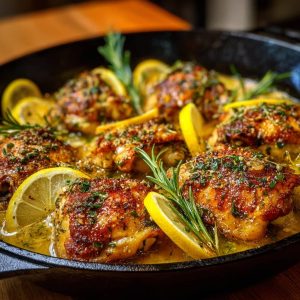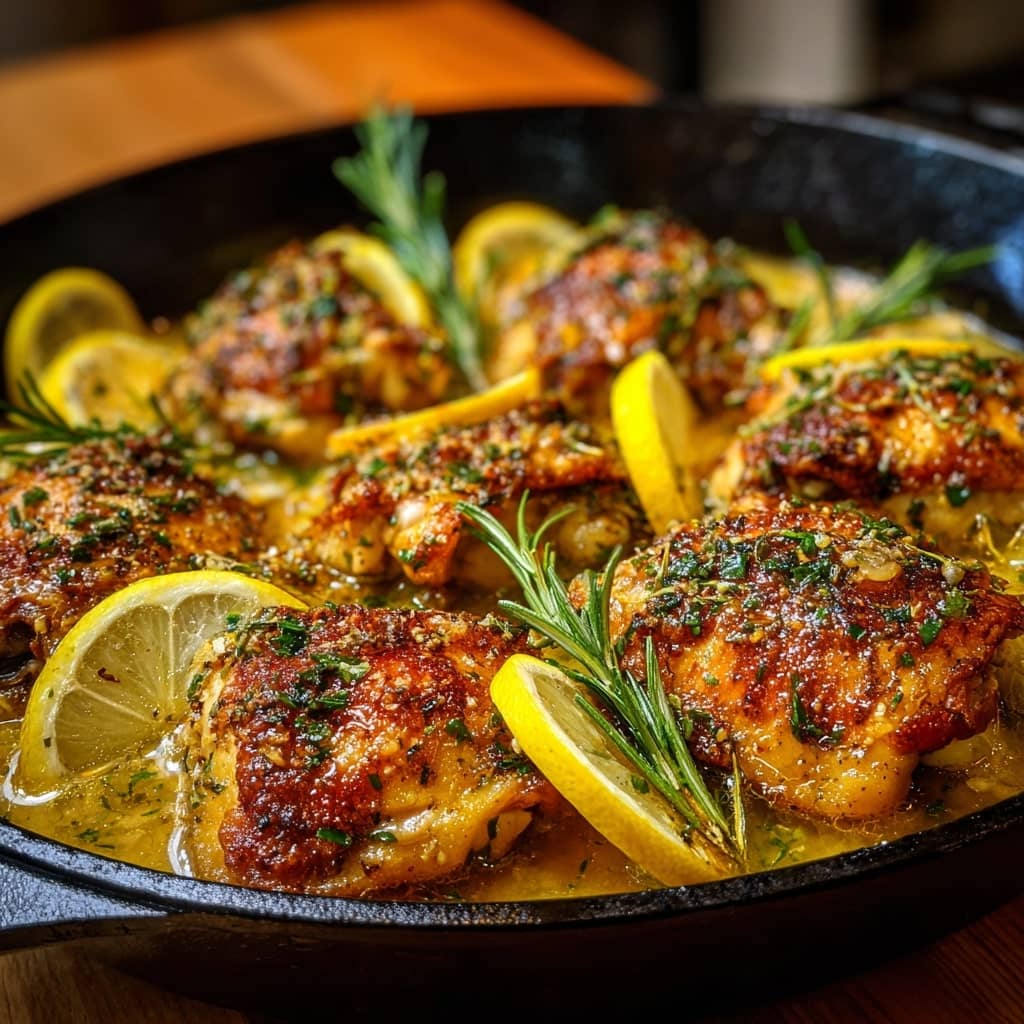Introduction One Pan Lemon Chicken is a flavorful, easy-to-make dish that brings together tender chicken and a bright, zesty lemon sauce all in one pan. This recipe is perfect for busy weeknights, providing a delicious, balanced meal with minimal cleanup. The combination of juicy chicken, aromatic herbs, and a tangy lemon glaze makes this dish both refreshing and comforting, satisfying the taste buds while being simple to prepare. It’s the kind of dish you can throw together in no time, whether you’re cooking for a crowd or making a quick dinner for yourself. The beauty of One Pan Lemon Chicken lies in its simplicity, as the chicken bakes to perfection while absorbing all the flavors of the lemon, garlic, and herbs. It’s an excellent choice for those looking for a light, healthy, yet satisfying meal.
The History of One Pan Lemon Chicken The concept of one-pan meals dates back to the early 20th century when busy families and working professionals sought ways to simplify cooking while still creating flavorful dishes. Combining proteins like chicken with fresh ingredients and seasonings in a single cooking vessel was an easy way to get a nutritious meal without a lot of fuss or cleanup. As culinary techniques evolved, the use of citrus, especially lemon, became widespread across many cuisines, particularly Mediterranean and Italian. These regions have long celebrated the use of lemon in both savory and sweet dishes, often pairing it with fresh herbs and olive oil to create light, zesty meals. One Pan Lemon Chicken, while a modern convenience, is rooted in these timeless flavor combinations and cooking techniques, making it an approachable and satisfying dish that has gained popularity in home kitchens around the world.
Ingredients Breakdown The ingredients for One Pan Lemon Chicken are simple, but each plays a critical role in developing the dish’s bright, savory flavor profile. Boneless, skinless chicken breasts or thighs are the protein of choice here, as they cook evenly and absorb the marinade well. Olive oil serves as the base for sautéing and ensures the chicken remains moist while providing healthy fats. Fresh garlic adds depth, while lemon juice and zest bring the signature tangy brightness that defines this dish. Fresh herbs like rosemary, thyme, or parsley contribute earthy, aromatic flavors that elevate the overall taste. Chicken broth or stock adds richness to the pan sauce, which helps keep the chicken juicy and infuses it with savory flavor. Salt, pepper, and sometimes a drizzle of honey or Dijon mustard round out the seasoning, balancing acidity with sweetness and heat.
Step-by-Step Recipe Preheat the oven to 400°F (200°C). Season the chicken breasts (or thighs) with salt, pepper, and a generous sprinkle of Italian seasoning or your choice of herbs. Heat 1-2 tablespoons of olive oil in a large oven-safe skillet over medium-high heat. Add the chicken and cook for about 4-5 minutes on each side, until the chicken is golden brown. Once browned, remove the chicken from the skillet and set aside. In the same skillet, add another tablespoon of olive oil if necessary, then sauté 2-3 minced garlic cloves for about 1 minute, until fragrant. Add 1/2 cup of chicken broth, the juice and zest of 1 lemon, and 1-2 teaspoons of fresh herbs like rosemary or thyme. Stir to combine, scraping up any browned bits from the bottom of the pan. Return the chicken to the skillet and spoon some of the sauce over the top. Transfer the skillet to the preheated oven and bake for 15-20 minutes, or until the chicken reaches an internal temperature of 165°F (74°C). Remove the skillet from the oven and let the chicken rest for a few minutes before serving. Garnish with freshly chopped parsley and additional lemon slices, if desired. Serve with roasted vegetables, rice, or a fresh green salad for a complete meal.
Tips for the Perfect One Pan Lemon Chicken To ensure the chicken is perfectly cooked, use a meat thermometer to check for an internal temperature of 165°F (74°C). If you’re using chicken breasts, consider pounding them to an even thickness before cooking to promote even browning and cooking. For extra flavor, marinate the chicken in the lemon-garlic-herb mixture for 30 minutes to 1 hour before cooking. When cooking the chicken, avoid overcrowding the pan; you want the chicken to brown, not steam. If your skillet has a lot of chicken juices, you may need to carefully spoon out a little before adding the broth to avoid a too-liquid sauce. For an even richer flavor, add a tablespoon of butter at the end of the cooking process to enrich the sauce. If you prefer crispy chicken skin, use bone-in skin-on chicken and sear it skin-side down before transferring it to the oven.
Variations and Customizations One Pan Lemon Chicken is a versatile recipe that can easily be adapted to suit different tastes or dietary needs. You can substitute chicken breasts with thighs or drumsticks for a richer flavor, as dark meat tends to stay juicier. For a different flavor profile, try adding a splash of white wine or balsamic vinegar to the sauce for extra complexity. If you like a bit of heat, add red pepper flakes to the sauce for a spicy kick. You can swap the lemon for other citrus fruits like lime or orange to create unique flavor variations. For those following low-carb or keto diets, serve the chicken with cauliflower rice or steamed vegetables instead of traditional grains. You can also add vegetables like zucchini, bell peppers, or asparagus to the pan during the last 10 minutes of cooking for a one-pan, complete meal. For a dairy-free version, simply omit any butter from the recipe or substitute it with coconut oil.
Health Considerations and Nutritional Value One Pan Lemon Chicken is a healthy, well-balanced meal that offers a good amount of lean protein from the chicken while being low in carbs. The olive oil used in cooking provides heart-healthy monounsaturated fats, while the lemon juice offers a burst of vitamin C. Garlic and herbs like rosemary and thyme not only enhance flavor but also come with antioxidant properties, supporting the body’s immune system. If you’re looking for a gluten-free option, this dish naturally fits the bill. It’s also suitable for paleo and keto diets, especially when paired with low-carb vegetables or cauliflower rice. The chicken provides essential amino acids, which are important for muscle repair and growth. While the dish is already light, you can further reduce the calorie count by using less oil or serving with more vegetables and fewer high-carb sides.
FAQ Q: Can I use bone-in chicken for this recipe? A: Yes, bone-in chicken works great, though it will require a longer cooking time—about 30-35 minutes. Just be sure to check the internal temperature for doneness. Q: Can I make this recipe with chicken thighs instead of breasts? A: Absolutely! Chicken thighs are juicy and flavorful and work well in this recipe. You may need to adjust the cooking time slightly depending on the size of the thighs. Q: Can I add vegetables to this dish? A: Yes, you can add vegetables like zucchini, bell peppers, or asparagus to the skillet in the last 10-15 minutes of cooking. They’ll absorb the lemony sauce and make the meal even more satisfying. Q: Can I make this recipe ahead of time? A: While the chicken is best enjoyed fresh, you can marinate the chicken for up to 24 hours in the fridge to enhance the flavor. Leftovers can be stored in an airtight container for up to 3 days. Q: What sides should I serve with One Pan Lemon Chicken? A: This dish pairs well with rice, quinoa, roasted vegetables, mashed potatoes, or a simple green salad. For a low-carb option, try cauliflower rice or roasted Brussels sprouts.

One pan Lemon Chicken
Ingredients
- 4 boneless skinless chicken breasts (approximately 2 pounds), pounded to 1/2-inch thickness
- 1/2 teaspoon kosher salt plus extra for seasoning
- 1/4 teaspoon freshly ground black pepper plus extra for seasoning
- 1 tablespoon olive oil
- 3 tablespoons unsalted butter
- 1 small shallot finely diced
- 4 garlic cloves minced
- 2 tablespoons all-purpose flour
- 1 cup half-and-half or whole milk
- 1/2 cup low-sodium chicken broth
- Juice of 1 medium lemon roughly 3 tablespoons
- 2 tablespoons freshly chopped parsley
- 1 small lemon thinly sliced
Instructions
- Pat the chicken dry thoroughly with paper towels, then season generously with salt and pepper on both sides. Heat the olive oil in a 10-inch or larger skillet over medium-high heat until it starts to shimmer. If needed, work in batches and add the chicken to the pan. Sear the chicken until deeply browned on the bottom, about 6 to 7 minutes. Flip the chicken with tongs and sear the other side for another 6 to 7 minutes, until browned. Once done, transfer the chicken to a plate and set aside.
- Lower the heat to medium, and add the butter to the skillet. Once melted, toss in the shallot, garlic, 1/2 teaspoon salt, and 1/4 teaspoon pepper. Stir occasionally and cook for about 1 minute, until the shallots start to soften. Add the flour, stirring to coat the shallots and garlic evenly, and cook for an additional minute.
- Pour in the half-and-half or milk and chicken broth, stirring until the flour dissolves completely and any browned bits from the bottom of the pan are scraped up. Bring the mixture to a boil, then reduce the heat to a simmer. Return the chicken to the pan and let the sauce simmer for 3 to 4 minutes, until it thickens and coats the back of a spoon, with the chicken fully cooked through. Stir the lemon juice into the sauce, then garnish with chopped parsley and lemon slices. Serve immediately.

